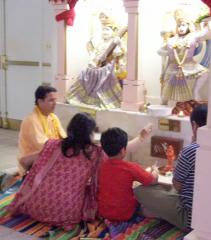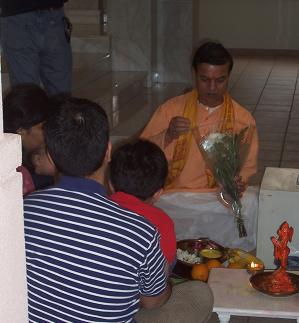|
I developed a strong interest in the Hindu religion from our readings and lectures, so I decided to explore this religion further through a couple of different encounters. My exploration included an interview with a colleague’s husband, attendance at the Holi Festival on March 6 at Rajdhani Mandir, and an interview with one of the worshippers at Rajdhani Mandir. I contacted one of the directors at Rajdani Mandir through e-mail, and she quickly responded to my e-mail. Her name is Kavita, and she was very enthusiastic about my interest. She graciously invited me to the Holi Festival and told me she could answer any questions I had about Hinduism. She warned me to wear washable clothes, because it is a festival of colors and they throw bright colors during the festival. Holi is a festival that marks the end of winter and the beginning of spring. The temple was swarming with people when I walked in. After placing my shoes in one of the rooms designated for holding shoes, I walked through a set of double doors into the prayer hall (Kavita said this is “technically” called the mandir/temple) with sculptures of deities set along side each wall of the room (about 16 deity images). There was a line of people receiving prasad and tikka (a red dot placed by the priest on the devotee’s forehead to represent the awakening of “spiritual eye” of the devotee). At the same time, two children were moving from one deity to another in the front of the room. The two would stand in front of Durga (the female deity sitting on a tiger), put their hands together over their mouth, and then rub their hands over their faces. Then the two children got down on their knees and kissed the floor in front of the deity, and stood up and repeated the same procedure with other deities in the front of the room. After spending some time in the prayer hall, I went downstairs where the cultural program was beginning. There was not one empty space on the large floor. I was fortunate enough to find a spot to stand in at the very back! The program was wonderful. Kids of all ages in beautiful gowns danced to lively music. I must admit I had a lot of anxiety about going into a different place of worship. It was so much different than anything I had experienced before. The only place of worship I had ever been in was the Catholic Church. However, as soon as I walked into the temple I felt very comfortable and at ease. I can’t pinpoint exactly what put me at ease; it was probably a combination of many factors. The most important one was the warm and inviting worshippers attending the festival who never once made me feel that I didn’t belong. Everyone treated me with warmth and respect, and they were so willing to help me find my way through the crowded temple. I loved being a part of this rich culture and experiencing the worship, music, food, clothing, language and most importantly, the people. There seemed to be such a special bond and wonderful sense of community among the worshippers. It was easy to see that this faith was not just a religion-it is their way of life. Unfortunately, I was only able to speak with Kavita for a couple minutes at the festival because she was responsible for directing the cultural program. However, I followed up my visit with an e-mail to ask her questions about some of my observations during my visit and general questions about the religion. She was so enthusiastic about my interest in the religion and answered my questions with very elaborate responses. She described the pooja ceremony in detail (I was not able to observe this because I went to a festival). At the pooja, there are many symbolic objects that represent various aspects of the faith. For example, a burning flame represents the divine Truth, and the hard shell of a coconut represents the ego and false knowledge we must break to arrive at the Truth. The pooja also includes chanting in Sanskrit, a sermon by the priest in Hindi, and a prasad of nuts, fruits, and holy water. The chanting is performed strictly according to the Vedas. She reinforced that how one says the prayers is just as important as what one says.
Kavita was very open about her personal thoughts about the temple and her religion. She loves Rajdhani Mandir because she feels so fortunate to have a priest to go to who a very educated man (PhD in Sanskrit) and very open to being questioned. She does have a small mandir in her home and she performs most poojas at home, but she enjoys the opportunity to go to the priest and ask questions that she is unable to comprehend from the scriptures. She revealed that what she loves most about her religion is that she has always found what she needs within the scriptures. She stated that the best way to describe the Hindu approach to life is, “We are not human beings having a spiritual journey, we are spiritual beings having a human journey” (one of our discussion questions!).
In addition to my visit and interview at Rajdhani Mandir, I took advantage of an opportunity to talk with my colleague’s husband, Jay Shah. He explained that most Hindus worship some form of Vishnu because Vishnu is the god responsible for everyday life. However, he said that geographic location has a strong impact on the form of Vishnu that is worshipped. For example, his family is from Gujrat and worships Srinaji (Krishna as a baby), while his wife’s family worships a form of Vishnu called Sri Venkataswara Swami because her family is from a different region of India. Furthermore, he explained that most Hindus pray to other gods for specific purposes. Ganesha is prayed to before one starts anything and is prayed to at the start of every service. When one is seeking wealth he/she may pray to Lakshmi. I also asked him to reflect on the Bhagavad Gita, and if there was anything part of Hinduism he didn’t agree with, or struggled with understanding. He explained that he agreed with Krishna’s message in the Bhagavad Gita about responsibilities, or “dharma”. He believes that we can not run away from responsibilities and our actions are part of a greater scheme. He also believes strongly in reincarnation and karma, and embraces the fact that you can take basic scientific concepts and apply them to this religion. For example, the belief that Atman is ever living and can not be destroyed is similar to the Newtonian law about energy. He disclosed that he did not agree with old concepts like the caste system and treatment of women, and discussed his struggles with choosing what to accept and what not to. However, he explained, “That’s why I like Hinduism. I don’t have to believe everything, as long as I believe in the basics like belief in God”. It was enlightening to pursue a more personal path towards learning more about Hinduism. I was particularly touched during my experience at the temple, where everyone was so inviting and treated me as if I was a member of the temple. Everyone I encountered, and especially Kavita and Jay, was more than willing to take the time to share their personal views and very enthusiastic about helping me understand more about their way of life. These encounters reinforced the Hindu messages of acceptance, respect and love for all beings. |
| Created by Laura Ellen Shulman |
Last updated: March 06, 2005
|

